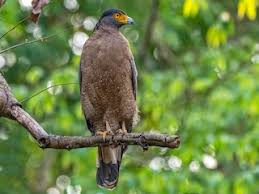
Crested Serpent-Eagle
Spilornis cheela
Order:
Family:
Size:
55 to 75 centimeters (22 to 30 inches)
Weight:
0.7 to 2.2 kilograms (1.5 to 4.9 pounds)
Taxonomy:
Louis Jean Pierre Vieillot 1822
Short Description:
The crested serpent eagle (Spilornis cheela) is a medium-sized bird of prey that is found in forested habitats across tropical Asia. Within its widespread range across the Indian Subcontinent, Southeast Asia and East Asia, there are considerable variations and some authorities prefer to treat several of its subspecies as completely separate species. In the past, several species including the Philippine serpent eagle (S. holospila), Andaman serpent eagle (S. elgini) and South Nicobar serpent eagle (S. klossi) were treated as subspecies of the Crested serpent eagle. All members within the species complex have a large looking head with long feathers on the back of the head giving them a maned and crested appearance. The face is bare and yellow joining up with the ceres while the powerful feet are unfeathered and heavily scaled. They fly over the forest canopy on broad wings and tail have wide white and black bars. They call often with a loud, piercing and familiar three or two-note call. They often feed on snakes, giving them their name and are placed along with the Circaetus snake-eagles in the subfamily Circaetinae. This medium-large, dark brown eagle is stocky, with rounded wings and a short tail. Its short black and white fan-shaped nuchal crest gives it a thick-necked appearance. The bare facial skin and feet are yellow. The underside is spotted with white and yellowish-brown. When perched the wing tips do not reach until the tail tip. In soaring flight, the broad and paddle-shaped wings are held in a shallow V. The tail and underside of the flight feathers are black with broad white bars. Young birds show a lot of white on the head. The tarsus is unfeathered and covered by hexagonal scales. The upper mandible does not have an overhanging festoon to the tip. The crested serpent eagle, as its English name suggests, is a reptile eater which hunts over forests, often close to wet grassland,[10] for snakes and lizards. It has also been observed to prey on birds, amphibians, mammals and fishes. It is placed along with the snake eagles of the genus Circaetus in the subfamily Circaetinae. It is found mainly over areas with thick vegetation both on the low hills and the plains. This species is a resident species, but in some parts of their range they are found only in summer. The call is a distinctive Kluee-wip-wip with the first note being high and rising. They call a lot in the late mornings from their perches where they spend a lot of time and they rise on thermals in the mornings.[3] In southern Taiwan, males have a larger home range than females. Males on average had a home range of 16.7 km2 while females used about 7 km2. When alarmed, they erect the crest and the head appears large and framed by the ruff. They will sometimes follow snakes on the ground. They roost in the interiors of trees with dense foliage.[16] A radio-telemetric study of the species in Taiwan found that the birds spend 98% of the day perched and usually finding food in the morning hours. They appear to use a sit and wait foraging strategy. In flight the wide white band is distinctive. The breeding season begins in late winter when they start courting and establishing territories. The eggs are laid in early summer. Old nests are often refurbished and reused in India but a study in Penang found them to build fresh nests each year. A study in India found that most nests were built along riverine trees. The nest is a large platform built high on a tree. Both birds in a pair build the nest but the female alone incubates. The male guards when the female forages. In central India, the Terminalia tomentosa is often used while Terminalia bellirica and Dalbergia latifolia was often used in southern India. In Penang, the nest trees were typically large and isolated from other trees with lot of room for the birds to fly in and out. The nests are lined with green leaves collected from nearby and are placed facing down on the nest floor. The usual clutch is one egg but two are sometimes laid and only a single chick is successfully raised in a season. When eggs are lost, a replacement is laid two to seven weeks later. The eggs hatch after about 41 days and the young fledge after about two months. Nests are defended by the parents. Only a couple of records from Pakistan, mainly from Murree Hills and Rawalpindi area, but no recent records.
Far far away, behind the word mountains, far from the countries Vokalia and Consonantia, there live the blind texts. Separated they live in Bookmarksgrove right at the coast
Crested Serpent-Eagle (Spilornis cheela) is distributed throughout various regions of Pakistan. These eagles are typically found in forested areas, including both lowland and mountainous regions. They are commonly observed in the northern and northwestern parts of the country, particularly in the forested regions of Khyber Pakhtunkhwa, Azad Jammu and Kashmir, and Gilgit-Baltistan.
Crested Serpent-Eagle (Spilornis cheela) exhibits typical behavior observed in its range. These eagles are often found in forested areas, including both lowland and mountainous regions. Their behavior primarily revolves around hunting for prey, which primarily consists of snakes, lizards, and other small vertebrates. ese eagles are also known for their impressive aerial displays, often engaging in soaring flights, especially during the breeding season. They may perform courtship displays, which involve aerial acrobatics and vocalizations to attract mates.
Far far away, behind the word mountains, far from the countries Vokalia and Consonantia, there live the blind texts. Separated they live in Bookmarksgrove right at the coast
About Photographer : Hello World
Facebook
Twitter
Instagram
Flicker
LinkedIn

